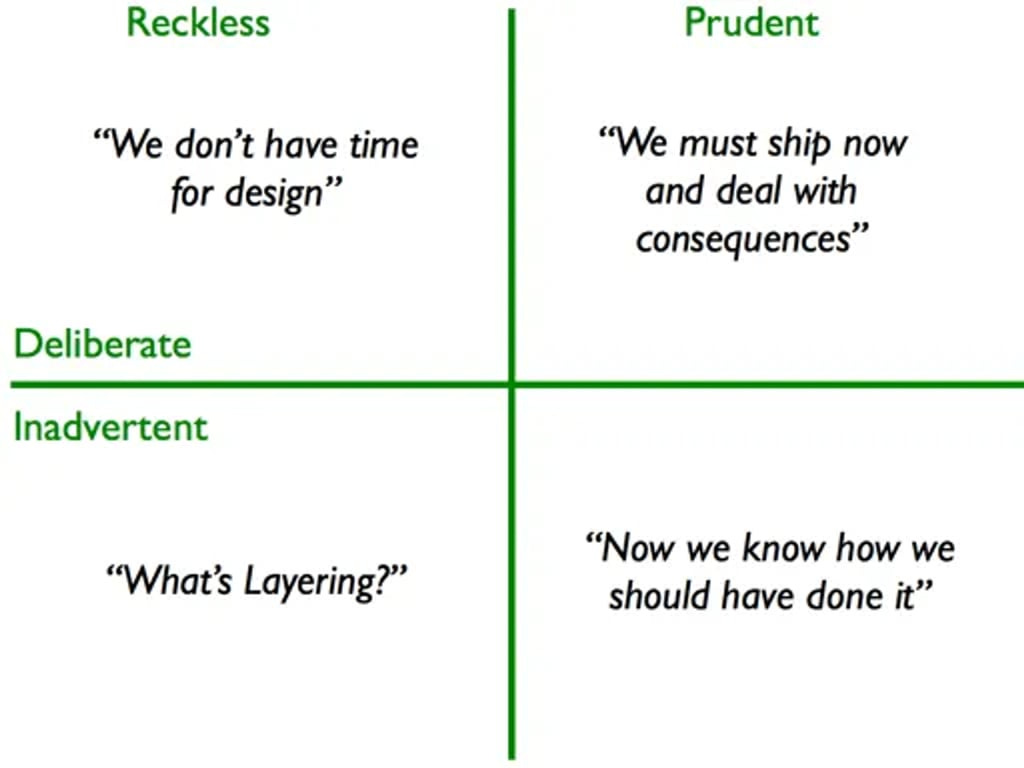Technical debt
This article delves into the concept of technical debt within the realm of software development, exploring its origins, implications, and how it can be effectively managed. It provides a comprehensive
Introduction
We were supposed to release this feature a couple of weeks ago. One developer got stuck on a framework update, another struggled with reorganizing the feature flags, and a third had to dig into an old repository to initiate database changes. As a result, the team is overwhelmed. Every feature release will feel like this until we can spend a few weeks addressing our technical debt. The challenge lies in getting the business to even consider this.
Here's the effect: the minute we mention "tech debt," everyone gets upset, but no one is listening. Each person assumes they know what we're all talking about, but their interpretations differ significantly. To the business, it sounds like the engineers are asking for three weeks without releasing any features. They remember the last time they granted those weeks: within a month, the team was overwhelmed again. When business leaders are reluctant to grant a "tech debt week" because the last one didn't improve the team's capacity, how can we expect them to agree to another?
In software development, technical debt is a familiar concept. Under tight deadlines, developers often take shortcuts to complete projects quickly. However, over time, these shortcuts accumulate into "debt" that must eventually be "paid back." Some amount of technical debt is virtually inevitable. Leaders and teams must balance business goals with myriad design and implementation decisions. A developer or team that only makes optimal choices will struggle to ship regularly and quickly.
💡
Technical debt has an intuitive advantage when it comes to definition: the name itself is more self-explanatory than most tech terms. From a business and financial perspective, "technical debt" functions similarly to financial debt. We take on technical debt for reasons akin to taking on financial debt: we need something now (or very soon) that we don’t have the resources to pay for in full. So we borrow to get what we need [How to explain technical debt in plain English]. In software, this generally means making coding or design decisions that are suboptimal—or that we know will need to be addressed and updated in the future—to get what we want or need into production sooner.
Here, the financial analogy becomes relevant again: we must use debt responsibly. We take on debt understanding that it will need to be repaid. Continuously accruing new debt without ever reducing existing balances will inevitably lead to problems—or even ruin—down the road.
Defining the Technical Debt
If you’ve been in the software industry for any period of time, you’ve likely heard the term “technical debt.” Also known as design debt or code debt, this metaphor is widely used in the technology space. It serves as a catchall term covering everything from bugs to legacy code to missing documentation. But what exactly is technical debt, and why do we call it that?
💡
Technical debt was originally coined by software developer Ward Cunningham, one of the authors of the Agile Manifesto and the inventor of the wiki. He used the metaphor to explain to non-technical stakeholders why resources needed to be budgeted for refactoring. His analogy was simple: with borrowed money, you can do something sooner than you might otherwise, but until you pay back that money, you’ll be paying interest. Similarly, rushing software out the door can provide short-term benefits, but it creates a "debt" that must be repaid through refactoring.
Years later, Cunningham described how he initially came up with the [technical debt metaphor]:
“With borrowed money, you can do something sooner than you might otherwise, but then until you pay back that money you’ll be paying interest. I thought borrowing money was a good idea, I thought that rushing software out the door to get some experience with it was a good idea, but that of course, you would eventually go back and as you learned things about that software you would repay that loan by refactoring the program to reflect your experience as you acquired it.”
The metaphor of technical debt is abstract, leading to various interpretations. However, it generally refers to the consequences of prioritizing quick delivery over perfect implementation. Technical debt accumulates when developers take shortcuts—using outdated libraries, writing poor quality code, or skipping proper testing and documentation—to meet deadlines.
Traditional software development follows a phase-based approach: feature development, alpha, beta, and golden master (GM). Each phase ideally addresses residual issues from the previous one. However, in reality, residual issues often get deferred, leading to a growing backlog of technical debt. This creates a cycle where new bugs appear as quickly as old ones are fixed, making it difficult to achieve a stable release. Deferred bugs and shortcuts create a dangerous cycle. As the number of unresolved issues grows, they become increasingly daunting to tackle, slowing down development and frustrating customers. This leads to a vicious cycle where schedules get derailed, and quality suffers.
In agile methodologies, the focus on rapid delivery and iterative progress can inadvertently contribute to technical debt. Agile teams often prioritize getting a working product out quickly, which can lead to shortcuts in planning, designing, coding, testing, or documentation. While this approach allows for quick releases and adaptability, it can also result in accumulating technical debt. Over time, these small compromises add up, creating a significant burden that slows down future development and reduces overall software quality. Managing this debt effectively is crucial to maintaining the long-term health of the project.
Developers often compromise best practices due to tight deadlines, immediate business needs, and changing requirements. Technical debt arises from these compromises. It represents the "build now, fix later" mentality. While it may offer short-term gains, it incurs long-term costs that can hinder future development.
Why build something knowing it will break down later? Technical debt is like taking a loan to get ahead quickly, with the understanding that it will require more work to fix later. It's a necessary trade-off in a fast-paced industry where speed often takes precedence over perfection.
Is Tech Debt really Bad?
💡
Technical debt is neither inherently good nor bad—it’s simply a tool. Like financial debt, it has both advantages and disadvantages. The key is to manage it responsibly. In a competitive market, the pressure to develop and ship quickly is immense, especially for startups. This often leads to the inevitable trade-off between taking on technical debt or delaying a launch.
Constantly deferring bugs and creating a backlog is dangerous. As these unresolved issues pile up, they become increasingly daunting, causing delays and reducing software quality. Customers may become frustrated with persistent defects, leading to dissatisfaction and potential loss of business.
Software developers often find themselves compromising best practices due to tight deadlines and shifting requirements. Technical debt results from these compromises, embodying the "build now, fix later" approach. While it may seem like a quick fix, it can have severe long-term consequences.
Agile teams generally view technical debt as an unavoidable part of the development process. Most software products carry some degree of technical debt, reflecting the reality of rapid development cycles where working software is the primary measure of progress. The consensus is that technical debt is manageable if addressed proactively and strategically.
Technical Debt: 3 Definitions in plan English
Part of responsible technical debt management lies in a straightforward understanding of the concept and how it manifests. Eventually, Let's arm you with some other definitions from the industry experts[https://enterprisersproject.com/article/2020/6/technical-debt-explained-plain-english]:
Justin Stone, Senior Director of Secure DevOps Platforms at Liberty Mutual Insurance:
Technical debt is the result of the design or implementation decisions you make and how those decisions age over time if they aren’t incrementally adjusted or improved. The longer you hold fast to those designs and implementations without incremental adjustments or improvements, the larger the debt, or effort, becomes to make those needed changes.
Christian Nelson, VP of Engineering at Carbon Five:
Technical debt is when the implementation – the code – for a product becomes unnecessarily complex, inconsistent, or otherwise difficult to understand. While there is no perfect code, code that contains technical debt [moves] farther [away] from a good solution for the problem it solves. The more debt, the farther the code misses the target. Technical debt makes it harder to understand what the code does, which makes it harder to build upon, and ultimately results in poor productivity and defects in the product.
Justin Brodley, VP Cloud Operations & Engineering at Ellie Mae and Co-host of The Cloud Pod:
Technical debt is the cost of technical decisions that are made for the immediacy, simplicity, or [budget] that, while easy today, will slow you down or increase your operational costs/risks [over time]. Most often it’s related to technical products, but can be found in most business processes and use cases. Many times this technical debt can turn into 'human spackle,' where knowledge workers do repetitive tasks that could be automated.
Impact
Technical debt is the consequence of choosing quick and cheap technology solutions over robust and efficient ones. This can occur due to time constraints, budget limitations, or lack of awareness about future needs. While often discussed in the context of software development, technical debt has significant implications for business operations.
Key Impacts of Technical Debt
Future Costs and Challenges 📈
Increased Effort and Resources: Like financial debt, technical debt incurs a cost that must be repaid in the future. Addressing suboptimal solutions will require additional resources, time, and effort.
Impact on Business Operations 🤨
Operational Inefficiencies: Technical debt can lead to inefficiencies, reduced productivity, increased maintenance costs, system failures, and security vulnerabilities. It can also hinder an organization's ability to adapt to new technologies or market changes.
User Dissatisfaction and Revenue Loss 💔
Negative User Experience: Technical debt often appears as bugs, which lower the user experience. This translates to increased expenses for customer service and lower revenues due to customer defections.
Longer Development Cycles 👋
Delayed Time to Market: As technical debt worsens, it becomes harder for developers to work within the existing code base, splitting time between developing new features and correcting old ones. This slows the software development lifecycle and delays time to market.
Reduced Productivity and Innovation 😫
Limited Innovation: Severe technical debt forces developers to service existing issues rather than focusing on building innovative new features.
Potential Security Problems 🤖
Increased Vulnerabilities: Technical debt can leave systems open to more vulnerabilities. These can be exploited by threat actors or insider threats, leading to security breaches laden with financial risk, including direct loss of assets, loss of business, and regulatory fines and penalties.
Views on Technical Debt Effects
Shaun McCormick:
I view technical debt as any code that decreases agility as the project matures. Note how I didn’t say bad code (as that is often subjective) or broken code.
McCormick suggests that true technical debt is always intentional and not accidental.
Technical debt happens when you take shortcuts in writing your code to achieve your goal faster, but at the cost of uglier, harder-to-maintain code. It’s called technical debt because it’s like taking out a loan. You can accomplish more today than you normally could, but you end up paying a higher cost later.
Uncle Bob:
A mess is not technical debt. A mess is just a mess. Technical debt decisions are made based on real project constraints. They are risky, but they can be beneficial. The decision to make a mess is never rational. It’s always based on laziness and unprofessionalism and has no chance of paying off in the future. A mess is always a loss.
Uncle Bob supports McCormick’s claim that bad code does not qualify as technical debt. By his definition, taking on technical debt is always intentional and strategic. This supports the idea that not every instance of technical debt falls into the same category. Understanding these nuances helps in making informed decisions about when and how to incur and manage technical debt.
Classification of Technical Debt
By intent and context
Technical debt can be categorized into three primary types, each with distinct characteristics and implications:
Intentional Technical Debt
Description: Created deliberately to expedite product delivery to market. This strategic decision is often made with the understanding that the debt will need to be addressed later.
Impact: Can accelerate time-to-market but requires planned efforts for future repayment and refactoring.
Unintentional Technical Debt
Description: Arises from sloppiness, unexpected complexity, or a lack of technical expertise. It includes poorly written code, overlooked design flaws, and inadequate documentation.
Impact: Leads to increased maintenance costs, reduced productivity, and potential system failures due to unplanned inefficiencies and errors.
Environmental Technical Debt
Description: Accrued over time due to the natural evolution of the software environment and lack of active management. This includes outdated technologies, deprecated libraries, and unaddressed infrastructure issues.
Impact: Causes performance degradation, security vulnerabilities, and increased downtime, requiring ongoing management and updates to mitigate its effects.
Martin Fowler's Technical Debt Quadrant
To better understand and categorize technical debt, it’s helpful to use Martin Fowler's "Technical Debt Quadrant," which classifies the type of technical debt based on intent and context:
Prudent and Deliberate: The team is aware they are incurring debt but choose to prioritize shipping and deal with the consequences later. This decision is acceptable if the stakes are small or the payoff for an earlier release is greater than the costs of the technical debt.
Reckless and Deliberate: The team knows about the consequences but still prioritizes speed over quality.
Prudent and Inadvertent: The team learns how the solution should have been implemented after the implementation.
Reckless and Inadvertent: The team lacks experience and blindly implements the solution, not realizing they are creating significant debt.
The left side of this quadrant, which includes reckless debt, should be avoided at all costs to maintain long-term software health and project success.
By type
In software development and enterprise IT, technical debt can manifest in different forms, each with its own causes and consequences. Understanding these types helps in effectively managing and mitigating technical debt.
In 2014, a group of academics proposed a framework for categorizing technical debt based on its nature. According to their paper, published by the Software Engineering Institute as “Towards an Ontology of Terms on Technical Debt,” there are 13 distinct types of technical debt:
1. Architecture Debt
Description:
Issues within the software architecture that hinder scalability, performance, or adaptability. Examples include monolithic architectures in need of microservices refactoring or poor modularization.
Impact:
Limits scalability and performance, making it difficult to introduce new features or adapt to new technologies. It can also lead to increased maintenance costs and complexity over time.
2. Build Debt
Description:
Problems related to the build process, such as slow, unreliable, or overly complex build pipelines.
Impact:
Increases the time required to build and deploy software, leading to slower development cycles, delayed releases, and increased frustration among developers.
3. Code Debt
Description:
Poor coding practices, lack of standardization, inadequate code comments, and outdated or inefficient coding techniques.
Impact:
Hinders code maintenance and scalability, making it harder to implement new features and increasing the likelihood of bugs and system failures.
4. Defect Debt
Description:
Accumulated unresolved defects or bugs that degrade software quality.
Impact:
Leads to lower user satisfaction, increased maintenance efforts, and potential system downtime. It can also cause a backlog of technical issues that slow down new development.
5. Design Debt
Description:
Flawed or outdated software design, including overly complex designs, improper use of patterns, and lack of modularity.
Impact:
Impedes scalability and the ability to introduce new features. It can also make the system more fragile and difficult to maintain.
6. Documentation Debt
Description:
Insufficient or outdated documentation that makes it difficult for team members to understand the system and the rationale behind certain decisions.
Impact:
Reduces efficiency in maintenance and development, leading to longer onboarding times for new team members and increased reliance on tribal knowledge.
7. Infrastructure Debt
Description:
Issues related to the environment in which the software operates, such as outdated servers, inadequate deployment practices, or the absence of disaster recovery plans.
Impact:
Results in performance issues, increased downtime, and higher operational risks. It can also make scaling the infrastructure more difficult and costly.
8. People Debt
Description:
Issues arising from team dynamics, skill gaps, or lack of training.
Impact:
Leads to suboptimal solutions and lower productivity. It can also cause increased turnover and a lack of cohesion within the development team.
9. Process Debt
Description:
Inefficient or outdated development processes and methodologies, including poor communication practices, lack of agile methodologies, and insufficient collaboration tools.
Impact:
Slows down development and reduces efficiency, leading to longer release cycles and higher project costs.
10. Requirement Debt
Description:
Unclear, incomplete, or changing requirements that lead to suboptimal implementation.
Impact:
Causes rework and delays, as developers may need to go back and adjust features to meet evolving requirements. This can also lead to misaligned expectations between stakeholders and the development team.
11. Service Debt
Description:
Issues related to service versioning, integration, and support for legacy systems.
Impact:
Leads to integration challenges and operational inefficiencies, making it difficult to maintain and upgrade services.
12. Test Automation Debt
Description:
Lack of automated testing, leading to increased manual testing and higher risk of defects.
Impact:
Slows down the development process and increases the likelihood of undetected bugs in production. It also makes regression testing more time-consuming and error-prone.
13. Test Debt
Description:
Inadequate test coverage and testing practices, including lack of unit tests, integration tests, and performance tests.
Impact:
Increases the risk of defects in production, leading to system failures and customer dissatisfaction. It also makes it harder to ensure the quality and stability of the software over time.
Each type of technical debt presents unique challenges and necessitates specific strategies for management and resolution. Recognizing and addressing these different forms of debt is crucial for maintaining a healthy and sustainable IT ecosystem within organizations.
Pay the technical debt
Measuring Technical Debt
Properly measuring technical debt helps ensure it doesn't accrue a problematic amount of interest and allows for effective management. However, measuring technical debt can be challenging. Several metrics can be used to measure technical debt, including the Technical Debt Ratio (TDR), defect ratios, code quality, completion time, and code reworking or refactoring.
Key Metrics for Measuring Technical Debt
Technical Debt Ratio (TDR)
Technical Debt Ratio (TDR) is a metric that estimates the future cost of technical debt relative to the overall development cost of a software system. The formula for TDR is:
💡
Technical Debt Ration=(Remediation Cost / Development Cost)×100
Remediation Cost: The estimated cost to fix the accumulated technical debt in the software system.
Development Cost: The cost incurred in developing the software system.
By multiplying the ratio by 100, we express TDR as a percentage, making it easier to interpret and compare.
Interpreting Technical Debt Ratio
Ideal TDR: An ideal TDR is around 5%. This suggests that the cost to fix the technical debt is 5% of the total development cost, indicating manageable technical debt levels.
High TDR: A high TDR indicates a significant amount of technical debt, suggesting that future maintenance and development efforts will be costly and time-consuming.
Low TDR: A low TDR suggests that technical debt is under control, and future development efforts will be less hindered by the need for extensive refactoring or bug fixing.
Example Calculation
Suppose a software project has the following costs:
Remediation Cost: $50,000 (the estimated cost to fix technical debt)
Development Cost: $1,000,000 (the total cost of developing the software)
Using the TDR formula:
TDR=(50,000/1,000,000)×100=5%
This means that the cost to fix the technical debt is 5% of the total development cost, which is considered an ideal and manageable level.
Defect Ratios
Measures the number of new defects compared with old ones. A high ratio indicates accumulating technical debt.
Code Quality
Evaluates the quality of the codebase using metrics such as cyclomatic complexity, code duplication, and adherence to coding standards.
Completion Time
Description: Tracks the time taken to complete tasks. Increased completion times may indicate rising technical debt.
Code Reworking or Refactoring
Description: Measures the frequency and extent of code changes due to reworking or refactoring efforts.
Capitalizing on Technical Debt
Software engineering salaries typically come from three budgets, influencing day-to-day work and career paths:
Sales/Marketing
Research and Development
Maintenance
Maintenance: Often focused on cost optimization, this budget includes sysadmins and platform engineers. Maintenance work is seen as a cost to minimize, and it is often undervalued.
One of the responsibilities of software engineering leaders is to ensure that the work their team performs is properly capitalized. Software that increases digital assets should also be added to financial assets, reducing tax liabilities. Maintenance work, however, is considered an expense and cannot be capitalized.
Technical debt can sometimes be packaged into mini-projects that can be capitalized, such as migrating to new infrastructure or significant rewrites leading to performance improvements. For example, resolving issues with an over-reliance on object-oriented programming constructs in a Scala codebase could result in a more maintainable system and improved performance. Identifying and addressing a group of technical-debt tickets can constitute a small project if the backlog.
Tracking Technical Debt
To stay ahead of and remain accountable for technical debt, teams need to track it through change management processes. One effective way to do this is by creating a technical debt registry.
Technical Debt Registry
A technical debt registry is a document that lists all existing issues, explains their consequences, suggests resources to fix the problems, and categorizes them by severity. As new problems arise and decisions are made, changes can be logged using a ticket or tracking system and prioritized in the registry.
Some project management tools include features to improve code quality and manage backlogs, helping teams to track and manage technical debt more effectively.
Best Practices to become free of technical debt
Track Tech Debt Meticulously 🕵️ Monitor, track, and prioritize tech debt like any other development challenge. You can't fix what you can't see.
Categorize Tech Debt 🧾 Distinguish between intentional (good) and unintentional (bad) tech debt to prioritize effectively.
Prioritize Critical Issues ❗ Address tech debt causing application failures or security flaws first. Less impactful issues can wait.
Integrate Tech Debt in Agile Processes 🧝 Ensure paying off tech debt is part of daily development, not indefinitely postponed.
Set and Adhere to Quality Standards 👩💻 Prevent accidental tech debt by discouraging sloppy coding practices.
Reward Maintenance Work 🏗️ Recognize efforts in maintaining and improving existing software, not just new developments.
Avoid Sudden Schedule Changes 📅 Provide realistic schedules to prevent tech debt from accruing due to last-minute changes.
Taming Your Team's Debt
Working with legacy code often means inheriting technical debt. Here are steps to manage it:
Define Technical Debt:
Technical debt is the gap between what was promised and what was delivered, including shortcuts taken to meet deadlines.
Clear communication between development and product management is essential to distinguish between tech debt, architectural changes, and new features.
Prioritize in Sprint Planning:
Include tech debt in sprint planning, not in a separate backlog.
Maintain a Strict Definition of Done:
Avoid adding separate testing tasks to user stories. Ensure testing is part of the original story to prevent tech debt.
Automate Testing:
When a bug is found, create an automated test for it. Fix the bug and rerun the test to ensure it is resolved. This is key to maintaining quality.
Action Items for Managing Technical Debt
Educate Product Owners: Highlight the true cost of technical debt to ensure accurate story point values for future resolutions.
Modularize Architecture: Adopt modular design and strictly manage tech debt in new components. As agility in new components becomes evident, extend these practices.
Write Automated Tests: Use automated tests and continuous integration to prevent bugs. When new bugs are found, create tests to catch them early in the future.
By following these best practices, teams can manage technical debt effectively, ensuring sustainable development and maintaining software quality.
Boeing's Technical Debt Case Study: The Cost and Evolution
The Genesis of Technical Debt
Boeing's technical debt began forming between 2015 and 2018, driven by a combination of design flaws, production challenges, and regulatory oversights. This period marked a critical juncture for the company as it faced mounting pressure to stay ahead of its competitors, particularly Airbus.
Accelerated Production Goals
In response to fierce competition from Airbus, Boeing expedited the development and production of the 737 MAX. This urgency strained the supply chain and led to numerous quality issues. Internal reports revealed chaotic production conditions, with out-of-sequence work and parts shortages forcing makeshift solutions like using concrete blocks on engine pylons to prevent tipping due to missing engines. This hasty approach to production compromised the integrity of the final product, leading to severe consequences later on (Politico) (FAA).
MCAS System Flaws
The Maneuvering Characteristics Augmentation System (MCAS) was designed to make the 737 MAX handle like previous models. However, inadequate testing and insufficient pilot training turned the MCAS into a critical factor in two fatal crashes. Boeing had initially not disclosed the MCAS to pilots, exacerbating the safety risks. This lack of transparency created a dangerous scenario where pilots were unprepared to handle the system's unexpected behavior (SpringerLink) (HouseTransCom).
Management and Regulatory Oversights
Boeing’s management prioritized speed over safety, a decision that proved costly in the long run. The minimal FAA oversight during manufacturing allowed quality control issues to persist unchecked, further contributing to the technical debt. This lack of stringent regulatory supervision created an environment where safety protocols were often bypassed in favor of meeting production deadlines (SpringerLink) (WEMU).
Consequences
The accumulation of technical debt had severe and far-reaching impacts on Boeing, affecting both its financial health and its reputation.
Alaska Airlines Incident
In early 2024, an Alaska Airlines flight experienced a midair blowout of a cabin panel door plug on a nearly new 737 MAX 9, forcing an emergency landing and highlighting ongoing quality control issues. This incident underscored the persistent problems within Boeing’s production processes and raised further questions about the reliability of the 737 MAX aircraft (MarketScreener) (Houston Public Media).
Reputational Damage
The 737 MAX crashes and subsequent investigations severely damaged Boeing’s reputation. Whistleblowers and employees highlighted systemic issues within the company’s culture and practices, exacerbating the trust deficit. This reputational damage has long-term implications, affecting customer trust and investor confidence (Politico) (SpringerLink).
Financial Impact
Boeing reported a GAAP net loss of $355 million in Q1 2024 and a negative free cash flow of $3.9 billion. To manage liquidity and upcoming debt maturities, Boeing raised $10 billion from the debt market. The total costs for technical debt and related issues are estimated to be around $20 billion, including settlements, fines, and additional safety measures. These financial strains have forced the company to rethink its strategies and focus on long-term sustainability (Fitch Ratings) (MediaRoom) (MarketScreener).
Mitigation Efforts
Boeing Whistleblower Issues New Warning: 'Tip of the Iceberg'
https://www.newsweek.com/boeing-whistleblower-richard-cuevas-says-problems-are-tip-iceberg-1920307
In response to the crisis, Boeing implemented several strategies to address its technical debt and restore confidence in its operations.
Production Adjustments
Boeing slowed production rates to ensure higher quality and safety standards. This step was crucial in addressing out-of-sequence work and quality control failures that had plagued the production lines. By taking a more measured approach, Boeing aimed to produce safer and more reliable aircraft (MediaRoom) (HouseTransCom).
Debt Financing
To stabilize its financial situation, Boeing raised $10 billion through bond markets. This move enhanced liquidity and helped the company manage its debt maturities more effectively. By securing additional funds, Boeing was able to invest in critical areas that required immediate attention (MarketScreener) (MarketScreener).
Quality Management Improvements
Boeing established a new safety board and appointed a chief safety officer to enhance its quality management systems. These changes were made in response to FAA feedback and internal audits, aiming to create a more robust framework for monitoring and improving safety standards. The new safety board is tasked with overseeing all aspects of production and ensuring compliance with regulatory requirements (Politico) (FAA).
Regulatory Compliance and Training
Boeing made significant revisions to the MCAS system, including using inputs from both angle of attack (AOA) sensors, limiting MCAS activation, and ensuring manual override by pilots. Additionally, Boeing mandated pilot simulator training for the redesigned system. These measures were critical in addressing the flaws that had led to previous accidents and ensuring that pilots were adequately prepared to handle the aircraft (SpringerLink) (HouseTransCom).
Cultural Shift and Employee Engagement
To address the underlying cultural issues, Boeing has initiated programs aimed at fostering a culture of safety and transparency within the organization. Employee engagement initiatives have been launched to encourage open communication and empower workers to report safety concerns without fear of retaliation. These efforts are intended to rebuild trust within the company and create a more collaborative work environment.
Long-Term Strategic Planning
Boeing is also focusing on long-term strategic planning to ensure sustainable growth and prevent the recurrence of similar issues. This includes investing in new technologies, improving supply chain management, and exploring new markets. By taking a holistic approach, Boeing aims to strengthen its position in the industry and build a more resilient organization.
These steps represent Boeing's concerted efforts to rectify the systemic issues that led to its technical debt. By addressing both the immediate and long-term challenges, Boeing aims to ensure a safer, more reliable, and financially stable future for its operations.
Conclusion
Technical debt, like financial debt, is a normal part of software development that needs careful handling. While it allows for quick progress, it can lead to long-term problems like lower software quality and slower development. The goal is to balance fast delivery with maintaining good, clean systems. To manage technical debt effectively, teams should keep track of it, prioritize fixing the most important issues, include debt resolution in their regular workflow, and understand its impact. By following good practices and promoting a culture of quality and responsibility, teams can reduce the risks of technical debt and ensure ongoing, high-quality software development.











